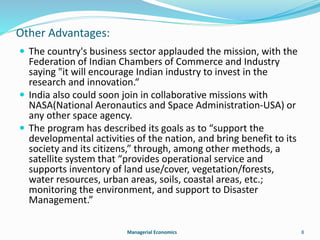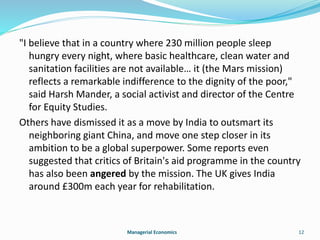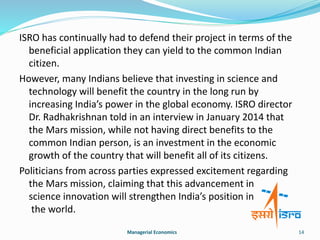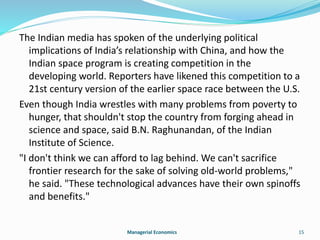Mars Orbiter Mission
- 1. Presentation on MOM Mars Orbiter Mission – An Achievement By India By Faisal Ahmed Khan, 1st Sem-MBA, HKBK-CE.
- 2. Introduction: The Mars Orbiter Mission (MOM), also called Mangalyaan "Mars-craft“ is a spacecraft orbiting Mars since 24th September 2014. It was launched on 5th November (Tuesday) 2013 by the Indian Space Research Organization(ISRO). It is India's first interplanetary mission and ISRO has become the fourth space agency to reach Mars, after the Soviet space program, NASA, and the European Space Agency. It is also the first nation to reach Mars orbit on its first attempt, and the first Asian nation to do so. Managerial Economics 2
- 3. Prime Minister Narendra Modi on congratulated India and ISRO scientists for creating history by successfully inserting the Mars Orbiter Mission into the Red Planet's orbit. Managerial Economics 3
- 4. Cost of the project: The total cost of the mission was approximately $70 million/427,00,00,000 (427cr), roughly one-tenth the cost of Maven(a project by NASA) and is the cheapest inter-planetary mission ever to be undertaken since Martian exploration began. The low cost of the mission was described by Kopillil Radhakrishnan, the chairman of ISRO, to various factors, including a "modular approach", a small number of ground tests and long (18-20 hour) working days for scientists. Author and commentator Chetan Bhagat tweeted that the cost of the mission was in fact cheaper than the opening ceremony of the Commonwealth Games hosted by New Delhi in 2010. Managerial Economics 4
- 5. BBC's Jonathan Amos mentioned that MOM used lower worker costs, technologies, simpler design, and significantly less complicated payload than NASA's MAVEN. An opinion piece in The Hindu newspaper pointed out that the cost was equivalent to less than a single bus ride for each of India's population of 1.2 billion. In simpler words approximately Rs. 4 per person. Managerial Economics 5
- 7. Objectives: The primary objective of the Mars Orbiter Mission is to showcase India's rocket launch systems, spacecraft-building and operations capabilities. Specifically, the primary objective is to develop the technologies required for design, planning, management and operations of an interplanetary missions. The secondary objective is to attract global investments as India's Mars mission is boon for its space business. Managerial Economics 7
- 8. Other Advantages: The country's business sector applauded the mission, with the Federation of Indian Chambers of Commerce and Industry saying "it will encourage Indian industry to invest in the research and innovation.“ India also could soon join in collaborative missions with NASA(National Aeronautics and Space Administration-USA) or any other space agency. The program has described its goals as to “support the developmental activities of the nation, and bring benefit to its society and its citizens,” through, among other methods, a satellite system that “provides operational service and supports inventory of land use/cover, vegetation/forests, water resources, urban areas, soils, coastal areas, etc.; monitoring the environment, and support to Disaster Management.” Managerial Economics 8
- 9. These satellites help people on the ground—like farmers, fisherman, and other agricultural professionals—by giving weather predictions. Their weather predictions have also helped in times of natural disaster, as they are used to evacuate civilians from dangerous areas preemptively. Limitation of Project MOM: MOM has less practical applications than any of ISRO’s previous ventures, and has therefore generated more opposition from the people who believe India should not be spending money on space exploration. Managerial Economics 9
- 10. Top 10 Countries ranked with Space Presence and Achievements: 1. United States of America 2. Russia 3. China 4. France 5. India 6. United Kingdom 7. Japan 8. South Korea 9. Iran 10. Israel Managerial Economics 10
- 11. AAM AADMI Opinions on MOM: Despite the relatively low cost of the Mars Orbiter Mission, the project has received some criticism from factions in India that believe the mission is a waste of government funds. This is a nation, where one-third of the population - 400 million people - live below the poverty line. This is a nation where more than 40 percent of children are malnourished and 1,655 children under 5 years old die every day from preventable diseases such malaria, diarrhea and pneumonia. To add to this is a nation where about 620 million people are forced to defecate in the open and many do not have access to clean drinking water. “Should we really be exploring Mars when we don't even have toilets for our people”, a journalist asked. Managerial Economics 11
- 12. "I believe that in a country where 230 million people sleep hungry every night, where basic healthcare, clean water and sanitation facilities are not available… it (the Mars mission) reflects a remarkable indifference to the dignity of the poor," said Harsh Mander, a social activist and director of the Centre for Equity Studies. Others have dismissed it as a move by India to outsmart its neighboring giant China, and move one step closer in its ambition to be a global superpower. Some reports even suggested that critics of Britain's aid programme in the country has also been angered by the mission. The UK gives India around £300m each year for rehabilitation. Managerial Economics 12
- 13. Brinda Adige, director of an NGO called Global Concerns India, which works on women’s and children’s issues in a slum population near Bangalore, voiced her disappointment at the allocation of government funding saying, “So much of money that is being spent to send a rocket into outer space, when we know that here on Earth, in our country there are children dying every day because they have no food to eat…the priorities are certainly not looking at children, women, human beings who are in need of basic necessities,” Reported by a news channel. Supporters, however, argue that the mission is the cheapest in the world. The Indian space program has received criticism of this kind from its beginning in 1963. Managerial Economics 13
- 14. ISRO has continually had to defend their project in terms of the beneficial application they can yield to the common Indian citizen. However, many Indians believe that investing in science and technology will benefit the country in the long run by increasing India’s power in the global economy. ISRO director Dr. Radhakrishnan told in an interview in January 2014 that the Mars mission, while not having direct benefits to the common Indian person, is an investment in the economic growth of the country that will benefit all of its citizens. Politicians from across parties expressed excitement regarding the Mars mission, claiming that this advancement in science innovation will strengthen India’s position in the world. Managerial Economics 14
- 15. The Indian media has spoken of the underlying political implications of India’s relationship with China, and how the Indian space program is creating competition in the developing world. Reporters have likened this competition to a 21st century version of the earlier space race between the U.S. Even though India wrestles with many problems from poverty to hunger, that shouldn't stop the country from forging ahead in science and space, said B.N. Raghunandan, of the Indian Institute of Science. "I don't think we can afford to lag behind. We can't sacrifice frontier research for the sake of solving old-world problems," he said. "These technological advances have their own spinoffs and benefits." Managerial Economics 15
- 16. Investment Attractions: Two-thirds of the parts for the Indian probe and rocket were made by domestic firms like Larsen & Toubro, the country’s largest engineering firm, Godrej & Boyce, and state plane-maker Hindustan Aeronautics Ltd. While such companies have a long way to go before they can attract big business in the commercial space sector, years of work on home-grown space projects are helping them become famous as suppliers of precision parts for related sectors like defence, aeronautics and nuclear energy. Larsen & Toubro has made $5.7 million in parts for ISRO in recent years. Managerial Economics 16
- 18. Indian market has to make it attractive for private companies to enter the satellite manufacturing and launch business. Also launchers from Russia, India and China are cheaper than that made in other countries, which creates competition between the three. India needs to consider significant changes to its space policy if it wants to create a thriving space industry. By ‘industry’, it means not just companies that supply parts to ISRO, but also companies that can go out and capture a chunk of the US$ 160-billion international market. Managerial Economics 18
- 19. This low-cost technology could bring in more revenue for India, say analysts, helping it capture more of the $304 billion global space market. So far, it has launched 35 satellites for other countries and is eager to do more. India is expected to capture at least one-fifth of the world satellite manufacturing and launch market "If we're going to earn money, we're going to do it on that," said D. Raghunandan of the Delhi Science Forum, a group that promotes the study of science. Managerial Economics 19
- 20. 20



















